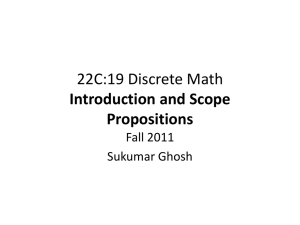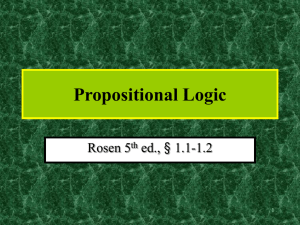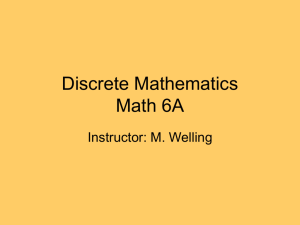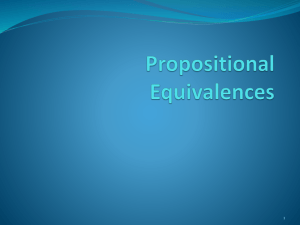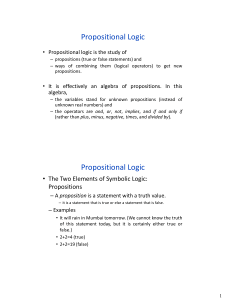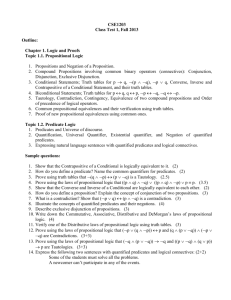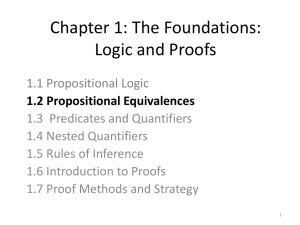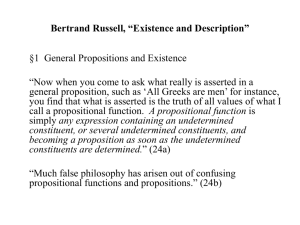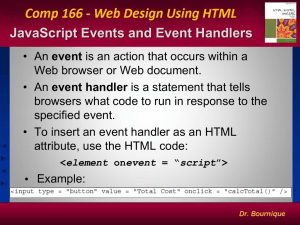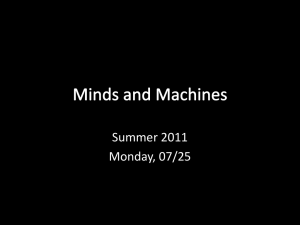Introduction and Scope
advertisement
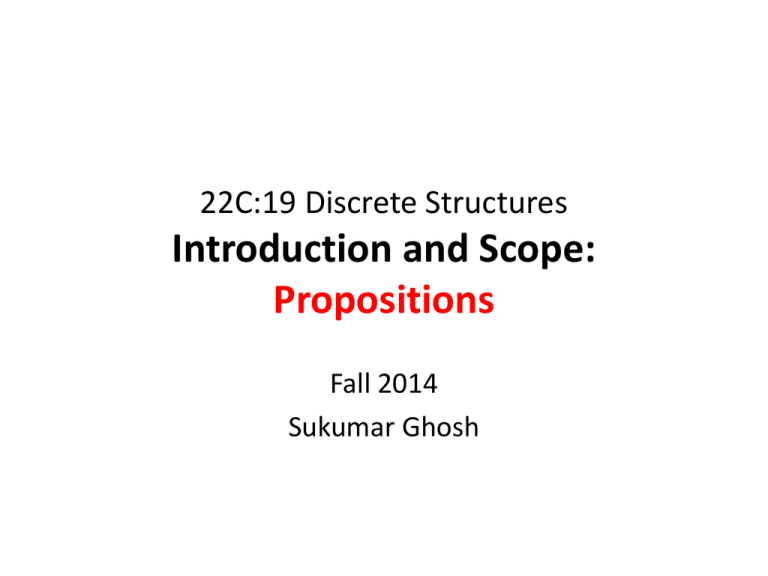
22C:19 Discrete Structures Introduction and Scope: Propositions Fall 2014 Sukumar Ghosh The Scope Discrete mathematics studies mathematical structures that are fundamentally discrete, not supporting or requiring the notion of continuity (Wikipedia). Deals with countable things. Why Discrete Math? Discrete math forms the basis for computer science: • Sequences • Counting, large numbers, cryptography • Digital logic (how computers compute) • Algorithms • Program correctness • Probability (includes analysis of taking risks) “Continuous” math forms the basis for most physical and biological sciences Propositions A proposition is a statement that is either true or false “The sky is blue” “Today the temperature is below freezing” “9 + 3 = 12” Not propositions: “Who is Bob?” “How many persons are there in this group?” “X + 1 = 7.” Propositional (or Boolean) variables These are variables that refer to propositions. • Let us denote them by lower case letters p, q, r, s, etc. • Each can have one of two values true (T) or false (F) A proposition can be: • A single variable p • A formula of multiple variables like p ∧ q, s ∨¬r) Propositional (or Boolean) operators Logical operator: NOT Logical operator: AND Logical operator: OR Logical operator: EXCLUSIVE OR Note. p ⊕ q is false if both p, q are true or both are false (Inclusive) OR or EXCLUSIVE OR? Logical Operator NAND and NOR Conditional Operator A conditional, also means an implication means “if p then q ”: Symbol: as in pq Example: If this is an apple ( p ) then it is a fruit ( q ) The antecedent The consequence Conditional operators If pigs can fly then 2+2=44. True or False? Conditional operators Set representations A proposition can also be represented by a set of elements for which the proposition is true. (Venn diagram) Venn diagram Bi-conditional Statements Translating into English Translating into English Great for developing intuition about propositional operators. IF p (is true) then q (must be true) p (is true) ONLY IF q (is true) IF I am elected (p) then I will lower taxes (q) p is a sufficient condition for q q is a necessary condition for p Translating into English Translating into English Example 1. p = Iowa q =Midwest IF I live in Iowa then I live in the Midwest I live in Iowa ONLY IF I live in the Midwest Example 2. You can access the Internet from campus ONLY IF you are a CS major or an ECE major or a MATH major, or you are not a freshman (f): (CS ∨ ECE ∨ MATH ∨ ¬ f) ⟶ Access Internet Precedence of Operators Boolean operators in search Tautology and Contradiction Equivalence Examples of Equivalence Examples of Equivalence More Equivalences Associative Laws Distributive Law Law of absorption See page 130 for a complete list De Morgan’s Law You can take 22C:21 if you take 22C:16 and 22M:26 You cannot take 22C:21 if you have not taken 22C:16 or 22M:26 How to prove Equivalences Examples? How to prove Equivalences How to prove Equivalences Propositional Satisfiability A compound propositional statement is satisfiable, when some assignment of truth values to the variables makes is true. Otherwise, the compound propositional statement is not satisfiable. Check if the following are satisfiable. 1. (p q) (q r) (r p) 2. (p q r) (p q r) 3. (p q) (q r) (r p) (p q r) (p q r) Solve this There are three suspects for a murder: Adams, Brown, and Clark. Adams says: “I didn't do it. The victim was old acquaintance of Brown. But Clark hated him.” Brown says: “I didn't do it. I didn't know the guy. Besides I was out of town all the week.” Clark says: “I didn't do it. I saw both Adams and Brown downtown with the victim that day; one of them must have done it.” Assume that the two innocent men are telling the truth, but that the guilty man might not be. (Taken from http://logic.stanford.edu/classes/cs157/2005fall/notes/chap0) Muddy Children Puzzle A father tells his two children, a boy and a girl, to play in the backyard without getting dirty. While playing, both children get mud on their foreheads. After they returned home, the father said: “at least one of you has a muddy forehead,” and then asked the children to answer YES or NO to the question: “Do you know if you have a muddy forehead?” The father asked the question twice. How will the children answer each time? (Russel’s) Paradox In a town, there is just one barber, he is male. In this town, every man keeps himself clean-shaven. The barber shaves all those, and those only, who do not shave themselves. Question: Does the barber shave himself? What is the answer is Yes? What if the answer is No? Wrap up Understand propositions, logical operators and their usage. Understand equivalence, tautology, and contradictions. Practice proving equivalences, tautology, and contradictions.
